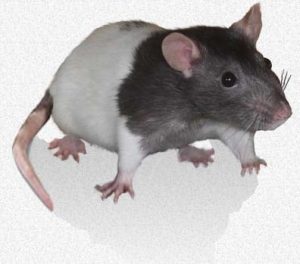The Rat-Lover’s Guide To Respiratory Disease
Mycoplasma Chronic Pneumonia –What Causes It And What You Can Do About It
Ron Hines DVM PhD
I like well-adjusted pet domestic rats. Their life span is brief when compared to our dogs and cats; but that is not necessarily a drawback.
 Domesticated rats do not require vaccinations – just a wholesome environment, your friendship and good nutrition. If you want to see what other non-traditional and zoo animals require in the way of vaccinations, click on the ark.
Domesticated rats do not require vaccinations – just a wholesome environment, your friendship and good nutrition. If you want to see what other non-traditional and zoo animals require in the way of vaccinations, click on the ark.
Some Day, You, or a Friend, Might Face This Situation:
You feel sorry for a sweet “feeder” rattling at some seedy pet store. You take it home. It becomes your buddy. Everything goes well for a year or so but then, especially in the evening, you hear sneezing. The rat seems to have just as much energy and enthusiasm as before. But as time goes by, its nose becomes crusty. As this progresses, you notice that the rat is breathing harder, wheezing and it’s weight has dropped. Now it is sneezing off and on all day. Mucusy or crusty brownish material drains from its nose and gets sneezed onto the walls of its terrarium. You are getting worried. You take your rat to a veterinarian. He thumbs through some books and puts it on antibiotics. He tells you it has an upper respiratory infection. Perhaps the rat gets better for a while. But the problem comes back again and again and the pet is now definitely uncomfortable. rat respiratory lung disease rat
The History of Your Pet Rat
Your rat’s Latin name is Rattus norvegicus. He now comes in innumerable colors and styles but he was once a brown creature living wild in southern Asia (not Norway). He found plenty of food and shelter near people, and by 1340 had become a pest that moved to all habitable areas in sailing ships. He was quite an unwelcome visitor. He arrived in Europe about 1346, and soon, over 23 million people became ill, 20-40% of the population.
But it was not the rat’s fault, he was as sweet and gentle as any of God’s creatures; it was just a flea he was carrying and the poor sanitation of the times. By 1856, folks were experimenting with rats in France. Living this life of ease, in cages, the rat’s genes changed, and he became quite mellow. Finally, a white litter was born in Switzerland, around 1906. Its descents were sent to Philadelphia PA. where the Wistar Scientific Institute used its bloodline to develop more new strains of rats than ever before or after. As I said, these rats didn’t join us alone. They brought along old “friends” when they jumped ship. Friends they had had since the dawn of time. Besides the plague, those friends included the mycoplasma, some viruses and bacteria that are now making your rat sneeze.
What Is The Life Span Of A Pet Rat?
Nature designed rats to live 3-4 years. But in the wild they almost never do. Some genetic strains live longer than others – certain ones no more than 1-1 1/2 years. As in people, female rats tend to live longer than male rats. It has also been discovered that limiting their protein and caloric intake as pups increases the length of their lives. rat respiratory lung disease rat.
Rat Strains and Genetics
I come from a research laboratory background, so I know lab rat strains best. Some are Out-bred. That is, bred to maintain the largest pool of genes possible. It takes about 5 generations and 100 pairs to establish an outbred strain. A few of the common outbred strains include the Sprague Dawley, Wistar and Long Evans rat, often called a hooded or piebald rat.
Other strains are Inbred. They result from 20 or more generations of brother to sister matings. These strains have the smallest possible gene pool and so are very, very alike in all respects. By the fortieth generation, they are 99.5% genetically alike. Scientists love them, because they are such predictable cookie cutter rats. The most frequently used inbred strains include the Fisher 344, the Lewis rat, the Brown Norway rat and the Wistar-Furth rat.
How Do Research Scientists Deal With Rat Respiratory Disease?
Until the 1960s, laboratory rats suffered from the same respiratory problems that your rat has. But as my first job, out of veterinary school in 1966, I was posted to the National Institutes of Health to help develop “clean” rats and mice that did not have these diseases.
What we did was perform cesarean sections on Sprague Dawley rats, that were big-bodied and great mothers. We passed the infants into sterile rooms or isolettes and bottle-fed them wearing gloves sterile clothing and masks. Some, we kept sterile. We called them Axenic rats or germ-free rats. The problem was that without bacteria, their intestinal (cecums/ceca) didn’t function well and the rats did not live long before they developing fatal intestinal twisting (torsions). So we had a microbiologist brew up the “Shadler Cocktail” – some innocent but important bacteria that we could give to them. They did great then. But now we had to think up a new word for them. We call them Gnotobiotic rats or defined bacterial and virus flora rats.
Because they were so expensive to produce, our rat production colonies were less controlled. We just tested them frequently to be sure they contained no virus, mycoplasma, dangerous bacteria or parasites. We called these huge colonies Pathogen-Free rats.
The rat you bought had no such controls – anything goes in the pet and snake-food trade. These are just called Conventional rats. They can have every murine (rat & mouse) parasite, mycoplasma, bacteria and virus under the sun. It is the respiratory mycoplasma – assisted by certain viruses and bacteria that are causing the problems your rat is now experiencing.
How Do Respiratory Tract Mycoplasma Harm My Rat?
The root of your rat’s problem is a very tiny organism – smaller than a bacteria-but a bacteria none-the-less, but bigger than a virus. It is named Mycoplasma pulmonis. Mycoplasma are a very small type of bacteria that are naturally resistant to antibiotics. (ref) In articles I often just called them MRM for Murine Respiratory Mycoplasmosis. This organism lives in mice, guinea pigs, and rabbits as well as rats but doesn’t seem to be as big a problem in those other species. These mycoplasma can even exist in your nasal passages. Should that occur, they are thought to do you no harm. In your pet store rat, the organism was lurking in the rat’s respiratory system from the day of its birth. Although clinically silent these mycoplasm have the potential to cause slowly progressive disease in the animal’s respiratory tract from its nose to its lungs. Although we think primarily about its effect on the lungs, it occasionally causes genital infections, sterility and arthritis too. It is the most important and common disease of rats.
Mycoplasma pulmonis is very infectious to rats and mice. Mycoplasmosis has been called many things: murine pneumonitis, infectious catarrh, enzootic bronchietasis, chronic respiratory disease (CRD), endemic murine pneumonia, viral pneumonia of rats, labyrinthitis, and chronic murine pneumonia. It is very infectious and generally passes through a sneeze – but it can even pass through the womb into a rattling before it is born. Once inside the rodent, it begins its life living in the nose and middle ear but causes no immediate disease. Its often accompanied by other buddies, (co-pathogens): Sendai virus, K virus, Cilia-Associated Respiratory Bacillus, Streptococcus pneumoniae, Corynebacterium kutscheri, Rat Coronavirus, Pneumonia Virus of Mice, Mycobacterium avium-intracellulare, Pneumocystis carinii, Chlamydia trachomatis, Chlamydia psittaci, Klebsiella pneunoniae, Streptococcus pyogenes, Mycoplasma neurolyticum and Mycoplasma collis (co- pathogens – think of them all as bad bugs).
What Are The Signs and Symptoms Of Mycoplasma Respiratory Disease?
What happens, and when it happens depends on a lot of interacting factors: some mycoplasma are stronger (more virulent) than others. More importantly, the number of other bacteria and virus that hitched a ride in your rat is very important as to when or if this disease develops. The symptoms include sneezing, crusty and runny nose and watery eyes. Over time this can progresses to loss of appetite, hair coat, wheezing, difficulty breathing and unkempt hair coat. Later, bronchitis, pneumonia, and emphysema develop. I would sometimes visit my conventional (contaminated) colonies at Baltimore City Hospital in the middle of the night – the sound was like a host of hoarse crickets all chirping and sneezing together.
Some Scientific Information About Mycoplasma:
Mycoplasma are bacteria that do not have a cell wall and have the smallest number of genes necessary for any free-living thing. There are lots of different mycoplasma. They affect all kinds of animals and even plants and some of the “flu”s we get are actually due to Mycoplasma pneumoniae. Physicians call this “Walking Pneumonia” and it is also linked to arthritis and neurological disorders. But don’t be frightened, this is an entirely different mycoplasma. When I look for ways to treat your rat, I must look as to how physicians treat mycoplasmal pneumonia because no other recent information is available.
What Are Some Ways to Prevent Mycoplasma From Entering A Rodent Colony ?
For private rat breeders and owners the key to keeping disease out of your animal(s) can be reduced to three words: isolation, sanitation & isolation.
Prevention of murine mycoplasmosis involves placing mycoplasma-free rats into a barrier-sustained facility. These are closed, scrupulously clean, structures where strict husbandry standards, exclusion of wild rodents, serologic and postmortem monitoring, good ventilation, and low population densities in cages and rooms contribute to the maintenance of mycoplasma-free conditions. Needless to say, it is expensive.
Hysterectomy (Cesarean section) delivery is the only known means of establishing an M. Pulmonis-free breeding colony from previously infected stock. Due to the frequent localization of this microorganism around and in the uterus, not every litter will end up mycoplasm-free.
Rats used in research colonies are obtained from various commercial and institutional sources. It is important that the mycoplasma status of these animals is known and that the rats are housed by vendor or in groups with a similar microbial (bacterial) status. I check them frequently by attempting to grow mycoplasma from swabs of the nasal cavity, middle ear, trachea, and uterus-oviduct (remember, this bug hangs out frequently in the reproductive system). We also do blood tests that tell us if mycoplasm have slipped in. One suspicious sign is when the rats start having smaller weaker litters. Older females seem more susceptible to this reproductive form of the disease. It can also show itself as creaky, puffy and arthritic legs in older animals.
When I examine a rat for mycoplasma disease, I begin by looking in its nasal cavity and the “cleft” in its palate (the naso-palatine ducts). I look for snotty material, mucous, and little ulcers or red dots – all signs of inflammation. Then I look in the rat’s sinuses for the same sort of problems. In older rats I look for mineralization of the trachea (windpipe) – although this is common in all old rats. Normal lungs are a uniform light rosy pink color and float high in water. Rats with advanced mycoplasmosis have grayer, heavier, wetter lungs.
Can How I Keep My Rat Delaying the Onset of Mycoplasmal Pneumonia?
Yes.
If your rat came from a pet store rat source, you can safely assume it came with some mycoplasma. How this will affect the life of your ratty depends on some things that you can control and some things that you can’t.
First, the things you can’t change:
1) Some strains of mycoplasma are stronger (more virulent) than others – you don’t know which strain(s) are present.
2) Some strains of rats are genetically hardier than others. Fisher 344 strain seems the most resistant to mycoplasma
disease while Lewis rats seem the most susceptible.
3) The mycoplasma probably didn’t come alone. Other freeloaders came with it: most likely bacteria, and virus – maybe parasites as well.
4) It had a rough life in the pet store and where ever it was bred. The momma rat was probably worn out from
producing litter after litter and may not have passed much immunity on to the rattling.
5) A rat-year is about equal to 25 human years, so each rat month equals about 2 of our years. So the older the
rat is when you get it, the more advanced the disease is likely to be.
Now the Good News!
1) Early in the rats pup’s life, it should be checked for intestinal and superficial parasites that can be eliminated. This will improve its general health and immune system.
2) You need to put the rat on the highest-quality lowered caloric, lowered protein diet you can find. One that meets or exceed the nutritional requirements of rats as determined by the U.S. National Research Council (N.R.C.). Some good ones are a 16% protein block distributed by Teclad Harlan Sprague Dawley, Mazuri 5663 or ZuPreem Rodent Maintenance diet. Most quality brands meet N.R.C. guidelines on rat nutrition. However, their protein content, 23.5%, and caloric content is a bit too high for maximum longevity and their fiber content (3.8%) is too low. You can get around this by mixing it 50-50 with an equine range pellet, like Mazuri 5661 with 13% protein and 2.9% fat and 13.2% fiber. This will give you an 18% protein diet. With this mixture, the rats will attain their top body weight later in life, become reproductively active later in life, and, on the whole, live longer lives*. They are also less likely to suffer from kidney disease later in life. To this diet, I would add an additional 10 -12 units (iu) of vitamin E as well as a portion of the contents of a mixed anti-oxidant, anti-aging omega-3 microcapsule, and omega 3 and 6 fatty acids which stimulate the immune system that mycoplasm suppresses. Vitamin A deficiencies is known to speed the progress of mycoplasmosis in rats. However, too much vitamin A is also toxic and the diet I suggested has plenty of vitamin A.
3) The temperatures of your rat’s home should be kept between 65°F and 80°F. Temperatures should be kept as constant as possible – rats don’t do well when their temperature varies up and down a lot. Humidity should be between 30-70%. Twelve hours of light and twelve of darkness is a good ration but some rats breed better with 14 hours of light and 10 of darkness.
4) Good air quality is the most important thing you can provide for your rat to minimize the lung damage mycoplasma causes. It is this lung damage that ultimately causes the rat’s decline. First, they need to be kept in a dust and mold-free room, preferably with central heat and air-conditioning and at least four air changes an hour. We used 14 air changes per hour at N.I.H. The bedding material you use is extremely important. I like hard wood chips, next best is dust-free pine shavings. Worst are corncobs, cedar shavings and bentonite clays (cat litter products). Shredded ordinary newspaper with black soya ink is probably also OK – I have never used it. What you want to avoid is dust, mold, bacterial spores, airborne mineral products and atmospheric pollutants. These are all known to produce lung lesions in all animals. Of course, no wild rodents should have access to your rat’s room, food or utensils.
A Rat Club recently informed me that they believe pine shavings to be toxic to rats. It is true that some species of pine contain aromatic organic compounds that God put there to control insect and mold damage to the pine trees. In the US, shavings derived from “Yellow Pine” contain allot of these resins. However, shaving that are the byproduct of what the wood industry calls “White Pine” now predominate in the wood industry. You can tell the difference by simply sniffing the shavings. If they smell any way like Pine-Sol, don’t buy them. If you are in doubt, buy some other type of bedding.
5) Frequent cleaning of the rat’s cage and as much space per individual rat as possible is also very important. Rat’s urine breaks down into ammonia. Over time, this causes lung damage. Aromatic (pungent) cleaning compounds such as strong bleach, pine sol and perfumed products are also a bad idea. Bleach is an excellent
cleaning product – but it should be diluted to 1 part standard bleach in twenty parts water. The cages and utensils must be pre-cleaned in soapy water before being soaked in this mixture. Cage construction is very important. Cages should be made of durable smooth, non-porous and easily cleaned materials such as plastic or non-toxic metals.
6) Mycoplasma are more complex that virus. They never cause sudden (acute) disease. Because they utilize primarily RNA instead of DNA to reproduce, they are only killed by the protein-synthesis inhibiting, neucleophylic, antibiotics -the macrolides. These include dirithromicyin (Dynabac® no longer available in the US), clarithromycin (Biaxin®) and azithromycin (Zithromax®).
Biaxin® can be given to rats at 3.5 mg/kg three times a day for 20 days in combination with ranitidine and corticosteroids. Zithromax® can be given at 3.5mg/kg three times a day for 20 days. I have known rat owners to give as much as a miligram of Zithromax® to a 280 gm rat twice a day with no ill effects. Dynabac® is still available in some countries. It can be given at 2.5mg/kg three times a day for a twenty to thirty day period. After 30 days, the daily total dose must be lowered. All can cause loose stools and other digestive problems in rodents and must be given, supplemented with a good horse and ruminant bacterial jelly and brewer’s yeast. They are all best when given four times a day after food is consumed. They should be used at the lowest possible dose since double the pediatric dose can cause liver and kidney problems in rats. Most indigestion remedies interfere with macrolide absorption. I compound most in berry syrups, which must be shaken and kept refrigerated.
In 1935,Clyde McCay published a groundbreaking paper that showed that rats on calorically restricted (CR), nutritionally sound diets lived longer than rats that were allowed to eat as much as they wanted. Animals fed about 30 percent less than controls allowed to eat as much as they want, achieved an increase of about 40 percent in maximum life span. It has also been shown that CR retards or eliminates various chronic disorders, such as cancer, diabetes, and renal disease, and improves immune system function in lab animals (E. Masaro, American Journal of Clinical Nutrition, 55:1250S-52S, 1992).
Older remedies relied on destroying the freeloading bacteria that accompany the mycoplasma, such as Streptococci, Pasteurella, Klebsiella and Pseudomonas bacteria. We have nothing that will affect Sendai virus, another freeloader. Traditionally, chlortetracycline was given in the rat’s drinking water at 0.25mg/ml for 14-20 days or tetracycline, mixed fresh daily, in the drinking water at 2-5mg/ml and sweetened with Karo syrup. Some used Tylosin (a sulfa) at 25mg/378 ml of water.
Can I Obtain Rats That Are Free Of Mycoplasma?
University origin rats are not necessarily clean. Rats from the conventional colonies at Emory University, have enzootic Rat Parvovirus (RPV), Kilham’s Rat Virus (KRV, RV) and Toolan’s H-1 and have cultured positive for Helicobacter spp, Pasteurella pneumotropica, Proteus spp, Staphylococci, fecal coliforms and enterococci.
I have arranged to have your rat’s serum or pooled colony rat serum tested for antibody to: Mycoplasma Pulmonis, Pneumonia virus of mice (PVM); Kilhams rat virus (KRV); Toolans H-1 virus; Rat coronavirus (RCV); Sendai virus; CAR bacillus; Reovirus (Reo); Lymphocytic choriomenginitis virus (LCM); Mouse Adenovirus (Ms.Ad.); Tracheal cultures can be examined by any competent local lab for Pasteurella, Bordetella, Corynebacterium, Salmonella, and pathogenic streptococci. Sophisticated labs can culture for Mycoplasma pulmonis.
Research Discoveries That Might Help Us
Currently, work is going on in Europe and the United States to decode the approximate 677 proteins that make up rat mycoplasma. The hope is that soon a vaccine will be developed against the disease. The reason this work is going on is that if a vaccine could be produced against rat respiratory mycoplasma, it could probably also be produced against the serious mycoplasma diseases of people. It is the surface proteins that most intrigue researchers. These are the ones that give the mycoplasma stealth by suppress the rat’s immune system and prevent it from killing the bug. They also produce oxidative stress through the production of superoxide radicals, which is why antioxidants are so important to give your rats.
Are There Sources of Mycoplasma-Free Rats?
The three largest commercial vendors of mycoplasma-free rats in the United States that I once purchased from were Charles Rivers Laboratories, Harlan Sprague-Dawley Inc. and Taconic Farms. Some strains may be available from the Roscoe B. Jackson Laboratories. These institutions accept orders only from Universities and Research Establishments throughout the World. I could attempt to make contact with these breeders if enough rat enthusiasts were willing to pool their resources
**Newer drugs are never approved for use in pocket pets. But in 1988, Drs. Sedgwick and Pokras published a method of determining theoretical drug dosages for all warm-blooded animals using a process they called “Allometric scaling”. I have mislaid my copy of this article, but essentially it relies on the body weight of the animal and its core body temperature – both of which are easy to determine. I used this and FDA studies of the drugs in rats to determine the dosages.



